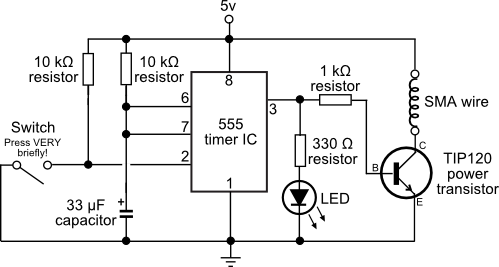Shape Memory Alloy Actuation with LM555 Timer IC
The problem with this setup is that it wastes battery power, and if the power switch is left on for too long it can damage the SMA strand. A more sophisticated approach uses an LM555 timer IC that automatically shuts off the current after a short time. The schematic below shows one way of connecting a 555 timer IC to control a length of SMA.

With the components shown, the timer produces a single pulse of about 400 milliseconds. But (and this is important) the pulse delay doesn’t start until you release the button. So press it only very briefly. The total ON time of the LM555 depends on how long you hold the switch down (let’s say 200 to 300 milliseconds, depending on how fast you are on the draw), plus the 400-millisecond delay built into the timer. Linger on the button and the wire may overheat, which can damage it.
You’ll know you’re applying too much current to the wire if you see a puff of smoke off its surface and/or the wire ceases to work like it should. If the wire no longer contracts when you apply current to it, toss that strand, chalk up the loss to experience, and begin experimenting with a new piece.
Note the LED: it’s there as a visual indicator whenever the SMA wire is getting juiced. Use the LED to test the ’555 circuit before connecting the SMA wire. If the LED stays on for too long after you push and release the button, you know to double-check your wiring and component selection.